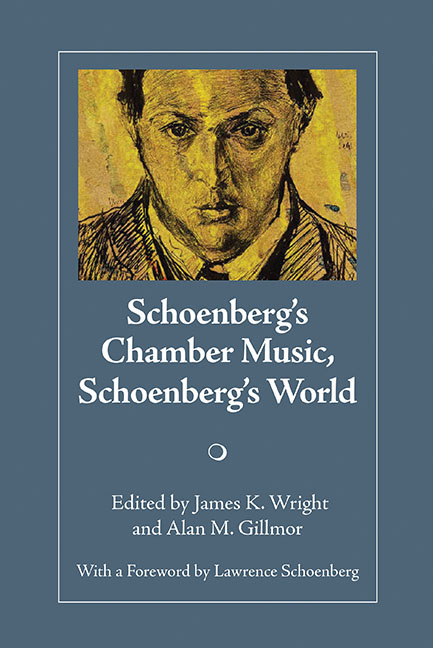Book contents
- Frontmatter
- Contents
- Foreword
- Preface
- HISTORICAL PERSPECTIVES
- ANALYTICAL PERSPECTIVES
- OTTAWA SYMPOSIUM AND CHAMBER MUSIC FESTIVAL PHOTOS
- PERFORMANCE, RECEPTION, AND INTERNATIONAL INFLUENCE
- Echoes of Pierrot Lunaire in American Music
- Expressivity, Color, and Articulation in Schoenberg's Seventeen Piano Fragments
- Critical Reception, Performance, and Impact of Schoenberg's Music and Thought in Canada Prior to 1960
Expressivity, Color, and Articulation in Schoenberg's Seventeen Piano Fragments
from PERFORMANCE, RECEPTION, AND INTERNATIONAL INFLUENCE
- Frontmatter
- Contents
- Foreword
- Preface
- HISTORICAL PERSPECTIVES
- ANALYTICAL PERSPECTIVES
- OTTAWA SYMPOSIUM AND CHAMBER MUSIC FESTIVAL PHOTOS
- PERFORMANCE, RECEPTION, AND INTERNATIONAL INFLUENCE
- Echoes of Pierrot Lunaire in American Music
- Expressivity, Color, and Articulation in Schoenberg's Seventeen Piano Fragments
- Critical Reception, Performance, and Impact of Schoenberg's Music and Thought in Canada Prior to 1960
Summary
The evolution of Schoenberg's concern for timbre, sonority, articulation, and expressivity is nowhere more evident than in his published piano works: Drei Klavierstücke, Op. 11, Sechs kleine Klavierstücke, Op. 19, Fünf Klavierstücke, Op. 23, Suite für Klavier, Op. 25, and Klavierstücke, Op. 33a and 33b. While some scholarly discussion has been devoted to these aspects of Schoenberg's piano works, the seventeen piano fragments left by the composer are less well known, and have rarely received attention from musicologists and performers. The set of fragments, taken collectively, span the years of the published works; the first was written around the year 1900, and the last after 1933. In this essay, I will undertake a brief overview of Schoenberg's seventeen piano fragments, giving particular attention to the parameters other than pitch and harmonic organization that are so central to the development of his compositional language.
We will pass briefly over the first four fragments (Examples 1-4), wherein the influence of Brahms is clearly evident. Schoenberg freely acknowledges his indebtedness to Brahms at this stage in his development:
I had been a “Brahmsian” when I met Zemlinsky. His love embraced both Brahms and Wagner and soon thereafter I became an equally confirmed addict. No wonder that the music I composed at that time mirrored the influence of both these masters.
The composer assigned a characteristically Brahmsian title, Scherzo, to the first fragment (Example 1). This eighty-measure fragment opens somewhat dramatically with dynamic octave doublings in the left hand establishing the key of F-sharp minor, and a strong melody in the right hand punctuated by colorful four-note chords. The expressive and dynamic language here is largely that of the nineteenth century, with occasional crescendo and decrescendo markings corresponding to melodic and phrase contours. After seventeen measures of this opening section, Schoenberg moves through a lyrical interlude, still in Fsharp minor, to modulate somewhat conventionally to the relative major, A major. A rather poetic B-section follows, featuring a more melodic and polyphonic texture. The entire fragment oscillates between these two textures, each of which explore the employment of wide registers, a characteristic associated with so much of Brahms's piano music.
- Type
- Chapter
- Information
- Schoenberg's Chamber Music, Schoenberg's World , pp. 193 - 206Publisher: Boydell & BrewerPrint publication year: 2009



